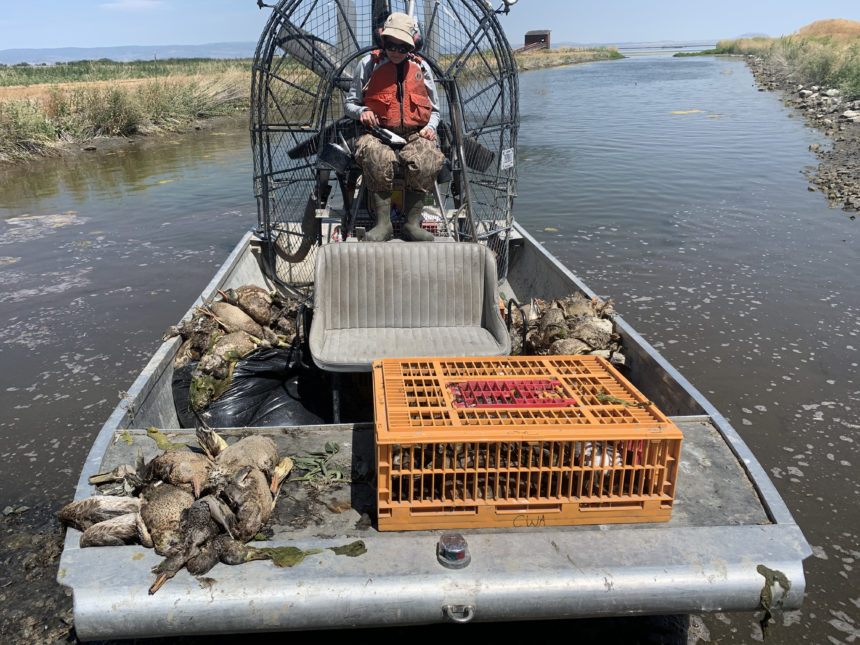
Lack of water can make botulism outbreaks much worse - and this year's outbreak was the worst in memory, with more than 40,000 ducks (mostly mallards) and shorebirds falling to the disease (see more below).
Welcome to the inaugural edition of California Waterfowl’s Save Lower Klamath! newsletter, a monthly update for our supporters who want to see an end to the Lower Klamath National Wildlife Refuge’s water crisis. We’ll use this newsletter to keep you abreast of developments that affect the refuge.
BIG PICTURE - HOW WE GOT HERE
-Our approach: huge goals, plus all the victories we can get
-The impact of failure: harm to Pacific Flyway populations
ACCOMPLISHMENTS
-Getting water flowing
-Video project
-Expanding support
IN THE NEWS
-Horrific botulism outbreak
-Articles
OUR PARTNERS AND ALLIES
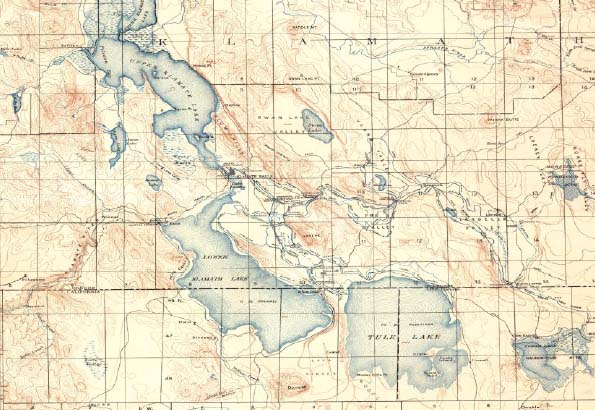
A 1905 map of the Klamath Basin showing that most of what is now the Lower Klamath National Wildlife Refuge was once a vast lake. Now the refuge struggles to get even tiny water supplies.
BIG PICTURE – HOW WE GOT HERE
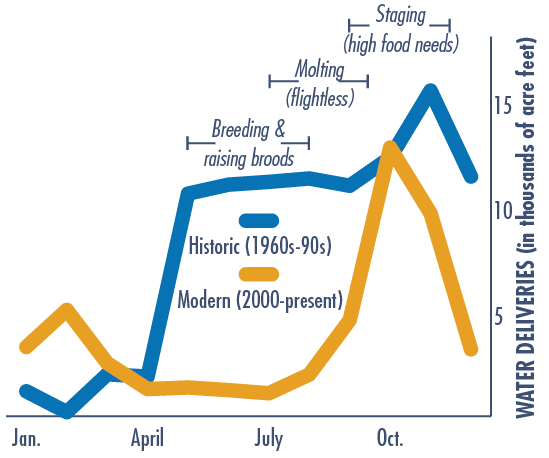 The Lower Klamath National Wildlife Refuge – the nation’s first NWR for waterfowl – is being starved of water at critical times in waterfowl’s life cycles. The immediate causes are:
The Lower Klamath National Wildlife Refuge – the nation’s first NWR for waterfowl – is being starved of water at critical times in waterfowl’s life cycles. The immediate causes are:
1) Water being diverted by the federal government and because of legal action in a so-far failed attempt to save three species of endangered fish (coho salmon, Lost River suckers and shortnose suckers).
2) The loss of affordable power in 2006 that the Tule Lake Irrigation District used to use to pump agricultural drain water from the Tule Lake NWR through Sheepy Ridge to Lower Klamath.
The roots of the problem, though, are that Lower Klamath has no senior water rights in the region.
Because this fight involves the Endangered Species Act and water rights – the thorniest of political issues in the West – it has proved intractable so far. But California Waterfowl is NOT giving up.
Our approach
We are working on two major solutions to the problem: Securing high-priority water rights for the refuge, and securing an agreement to distribute water more equitably in the Klamath Basin. A previous agreement – the Klamath Basin Restoration Agreement – died at the end of 2015 because Congress had not approved it.
However, recognizing that durable solutions like these take time, we also work in the meantime to secure every drop of water we can get for the refuge. (See "Accomplishments" below.)
The impact of failure
Eighty percent of all waterfowl in the Pacific Flyway use the Klamath Basin wetlands – of which Lower Klamath is key – at some point in their life cycle. The Basin is critically important to California mallards because it is both a breeding/brood-rearing area and a molting area. When there is insufficient water at Lower Klamath, the water dries up before ducklings can fly elsewhere for food, and molting ducks get crowded into smaller and smaller spaces. That can greatly exacerbate naturally occurring avian botulism outbreaks (see more below).
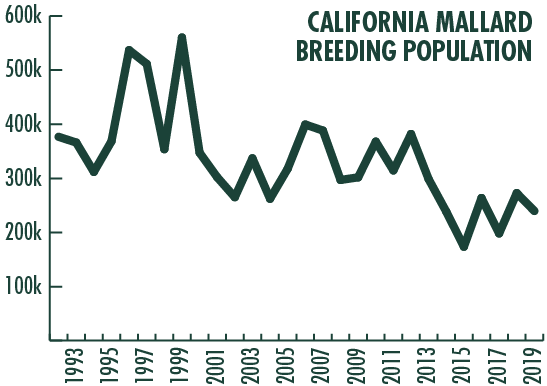 California’s breeding population of mallards – which supplies 60% to 70% of mallards harvested during hunting season in California – has been in decline, and poor conditions at Lower Klamath are a substantial part of the problem, causing a survival bottleneck. Research shows about half of the mallards that breed in the Central Valley head to the Klamath Basin to molt.
California’s breeding population of mallards – which supplies 60% to 70% of mallards harvested during hunting season in California – has been in decline, and poor conditions at Lower Klamath are a substantial part of the problem, causing a survival bottleneck. Research shows about half of the mallards that breed in the Central Valley head to the Klamath Basin to molt.
LKNWR is also a key staging ground for waterfowl migrating south for the winter and north for the spring and summer. When the refuge is dry, that leaves more birds in poor condition for continuing their migrations, which can reduce nesting success and winter survival.
To learn more about what's hurting mallard populations in California, and what CWA is doing about it, please click here.
ACCOMPLISHMENTS
Task Force
California Waterfowl created a high-power task force to fight for the refuge, made of CWA staff and current and former CWA board members, who collectively have a combined 180 years of advocacy, conservation leadership and water law experience. Click here to read more.
Getting water flowing
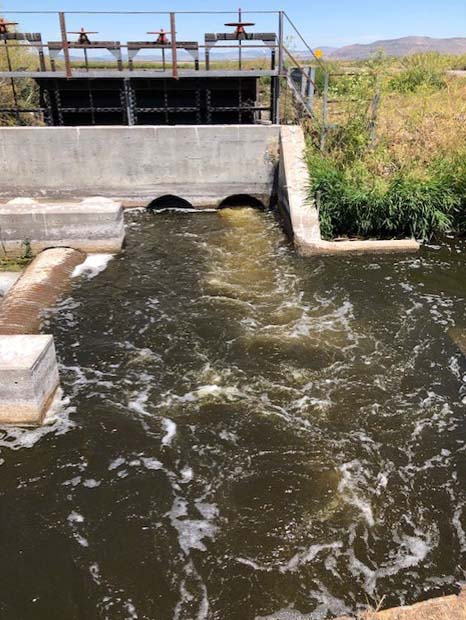 Lower Klamath’s problems are man-made, but nature piled on this year as the region experienced severe drought. California Waterfowl has fought repeatedly this year to get as much water as possible for the refuge:
Lower Klamath’s problems are man-made, but nature piled on this year as the region experienced severe drought. California Waterfowl has fought repeatedly this year to get as much water as possible for the refuge:
-In July, we met with U.S. Secretary of Interior David Bernhardt, U.S. Bureau of Reclamation Commissioner Brenda Burman, U.S. Reps. Doug LaMalfa and Greg Walden to restore some of the 11,000 acre-feet water that had been cut off as a result of drought cutbacks. The water began flowing within two weeks, helping keep Unit 2 of LKNWR flooded, saving thousands of ducklings that could not yet fly to find food and shelter elsewhere. Click here to read more.
-The Bureau of Reclamation announced in early September that it would be sending another 5,400 acre-feet in an effort to help curtail the region’s worst botulism outbreak in memory. Click here to read the press release.
-Two anonymous CWA donors ponied up $15,000 to pay one month of pumping costs for a well to get more water onto the refuge as migrating waterfowl were arriving. While the well’s capacity is limited, this water will help increase floodable acres in Unit 2 and help keep botulism from expanding there (see more below). It will also help maintain water levels in the unit, which will facilitate efficient movement of future water deliveries.
Video project
In August, we contracted with an award-winning videographer to film a short video that we will use to raise awareness about the problem – both in the general public and in Congress – and fight for solutions. The video – funded 100% by donors – is in progress, but here is one clip from this summer, when the film crew captured our efforts to alleviate the botulism outbreak at the Tule Lake and Lower Klamath NWRs.
Expanding support
In discussions with Congress and the U.S. Department of Interior, California Waterfowl has often been the sole conservation and hunting advocate for Lower Klamath and the waterfowl that rely on it – the battle centers primarily on water for farms, tribes and fish. But we are excited to have more conservation organizations joining us in this fight:
On Sept. 25, 12 other organizations that are part of the American Wildlife Conservation Partners sent a letter to Secretary of the Interior David Bernhardt asking for:
-Up to $60 million to purchase senior water fights for the refuge.
-Assurances that the Klamath Project can be used to store and deliver any purchased water rights.
-A source of affordable power to facilitate pumping water from Tule Lake to Lower Klamath.
Signatories to this letter were Congressional Sportsmen’s Foundation, Delta Waterfowl, Ducks Unlimited, Houston Safari Club, National Shooting Sports Foundation, North American Falconers Association, North American Grouse Partnership, Orion: The Hunter's Institute, Pheasants Forever, Quality Deer Management Association, Quail Forever and Theodore Roosevelt Conservation Partnership.
Click here to read the letter.
IN THE NEWS
Horrific botulism outbreak
 Some consequences of inadequate water supplies for Lower Klamath are hard to measure. For example, we can’t see how many ducklings perished as water levels at the refuge dropped this spring and summer. We don’t know how many ducks died during their flightless late-summer molt because they couldn’t find the safe haven that Lower Klamath typically supplies.
Some consequences of inadequate water supplies for Lower Klamath are hard to measure. For example, we can’t see how many ducklings perished as water levels at the refuge dropped this spring and summer. We don’t know how many ducks died during their flightless late-summer molt because they couldn’t find the safe haven that Lower Klamath typically supplies.
Unfortunately, we can count the ducks and shorebirds that died of botulism this summer at Tule Lake and Lower Klamath and conservatively extrapolate that data: More than 40,000. Over half the casualties were ducks, and most of the ducks were mallards.
Botulism isn’t caused by water shortages. It occurs naturally in the soil at the refuges and comes to life when temperatures climb in the late summer. This year, an early heat wave set botulism in motion in July – unusually early. Because water was in extremely short supply at the refuges, birds were concentrated in small areas, which greatly exacerbated the outbreak. Efforts to help fight a nearby fire also affected the ability to respond to the outbreak at neighboring Tule Lake’s Sump 1A, which was used as a source of water to help put out the fire. This year’s was the worst in memory for the region.
Articles
-Avian Botulism Kills 40,000 Birds at Lower Klamath National Wildlife Refuge – Audubon California, 9/9/20
-Avian botulism kills 40,000 birds, threatens millions more in Klamath Refuge (subscription required) – San Francisco Chronicle, 9/1/20
-Inside Klamath Refuge’s ‘Duck Hospital’: Crews save 2,000 birds infected with avian botulism (subscription required) – San Francisco Chronicle, 9/1/20
-This dead mallard shows why Klamath matters to the entire state – California Waterfowl, 8/28/20
-Wildlife refuges battle devastating botulism outbreak, worsened by water shortages – Herald and News, 8/24/20
-Klamath water arrives, saving 50,000 ducklings from certain death (subscription required) – San Francisco Chronicle, 7/24/20
-‘The kidney of the basin’ – Herald and News, 7/19/20
OUR PARTNERS AND ALLIES
Solving a problem as big as the Lower Klamath crisis can only be done in concert with a team of all-star partners and allies, starting with Klamath Basin farmers who are also struggling to get sufficient water, but nonetheless move heaven and earth to get more water to the refuge. This most notably includes the Tule Lake Irrigation District and Klamath Water Users Association.
We also rely heavily on information and voluntary efforts by local hunters in the Klamath Basin, most notably the Cal-Ore Wetlands and Waterfowl Council. Volunteers within Cal-Ore have done much to help improve habitat and hunting conditions on the refuge and pick up birds sickened or killed by avian botulism, among other important actions.
We are also grateful to all who have donated to our effort to save Lower Klamath, with contributions ranging from $25 to $25,000.


